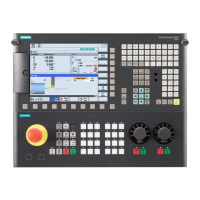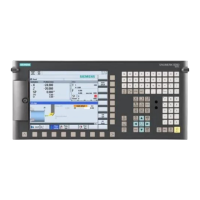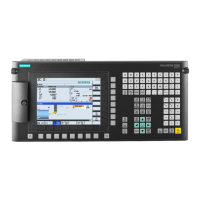Programming and Operating Manual (Turning)
96 01/2017
;Cylindrical thread with increasing lead
;Face thread with decreasing lead
;Taper thread with decreasing lead
N20 G0 G54 G90 G64 Z10 X60
; Approach starting point
; Thread, constant lead 5mm/rev
; Activation point at 15 degrees
; Starting pitch 5 mm/rev
; Pitch decreases 0.16 mm/rev
; Desired lead at end of block 3 mm/rev
Thread interpolation: G331, G332
Functionality
A position-controlled spindle with position measuring system is required.
With G331/G332, threads
compensating chuck can be drilled, if the dynamic response of the spindle and the axis
allow this.
If a compensating chuck is used nevertheless, the position differences to be compensated for by the compensating chuck
are reduced. This allows thread grinding at higher spindle speeds.
G331 applies for grinding, G332 for grinding in opposite direction.
The grinding depth is specified through the axis, e.g. Z; the thread lead through the corresponding interpolation parameter
(here: K).
For G332, the same lead is programmed as for G331. The spindle direction of rotation is automatically reversed.
The spindle speed is programmed with S; without M3/M4.
Before thread grinding with G331/G332, the spindle must be brought into the closed-loop position controlled mode using
SPOS=... .
Right-hand or left-hand thread
The
determines the direction of spindle rotation:
positive: right-hand (as with M3)
Negative: Left-hand (as with M4)
When cutting threads with G331/G332, you can determine the axis velocity based on the spindle speed and the thread lead.
However, the maximum axis velocity (rapid traverse) defined in the machine data cannot be exceeded; otherwise, alarms
will appear.
Metric thread M5
Lead: 0.8 mm/rev.
Diameter of the bottom hole: 4.2 mm
; Approach starting point
; Spindle in position control
; Thread grinding, K positive = Clockwise rotation of spindle,
end point -25 mm
